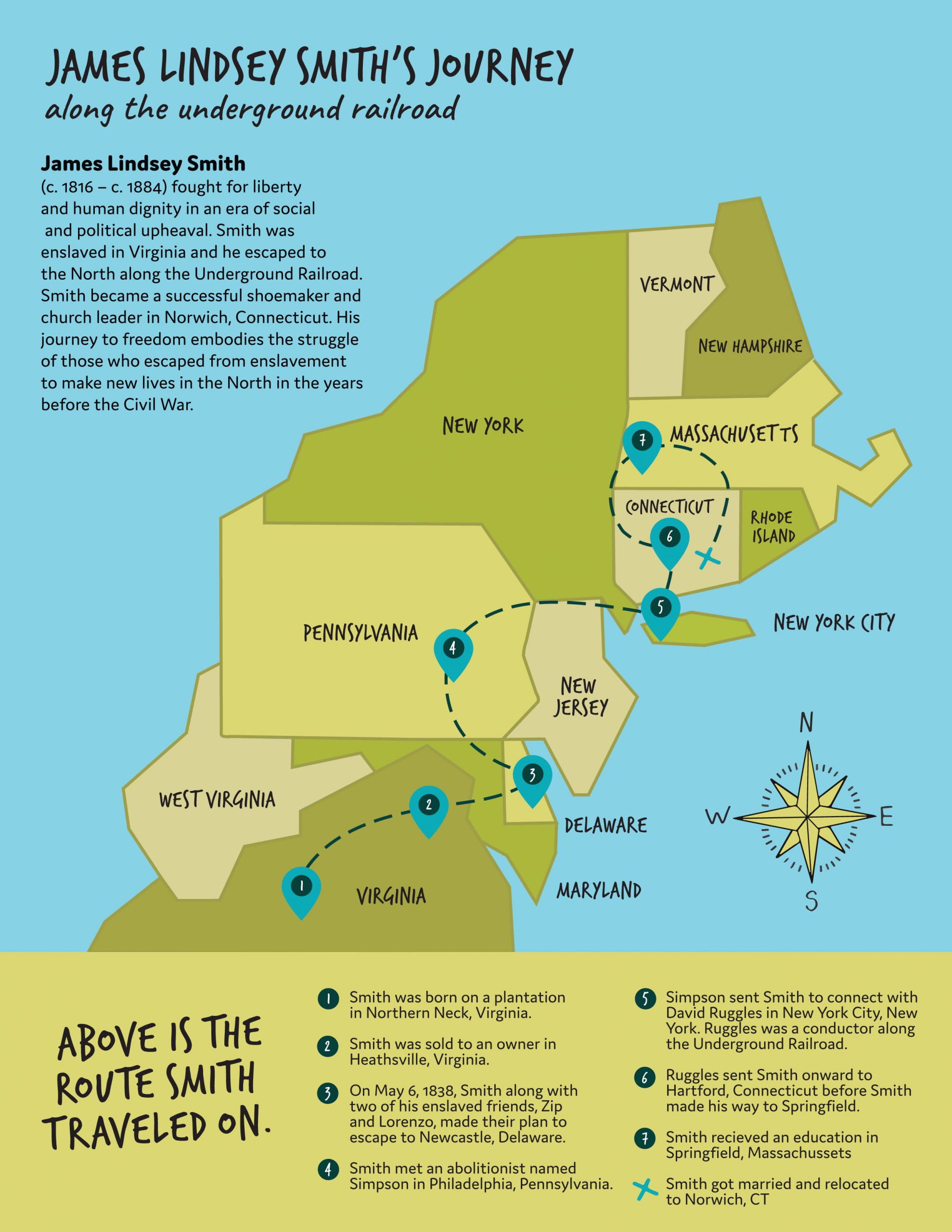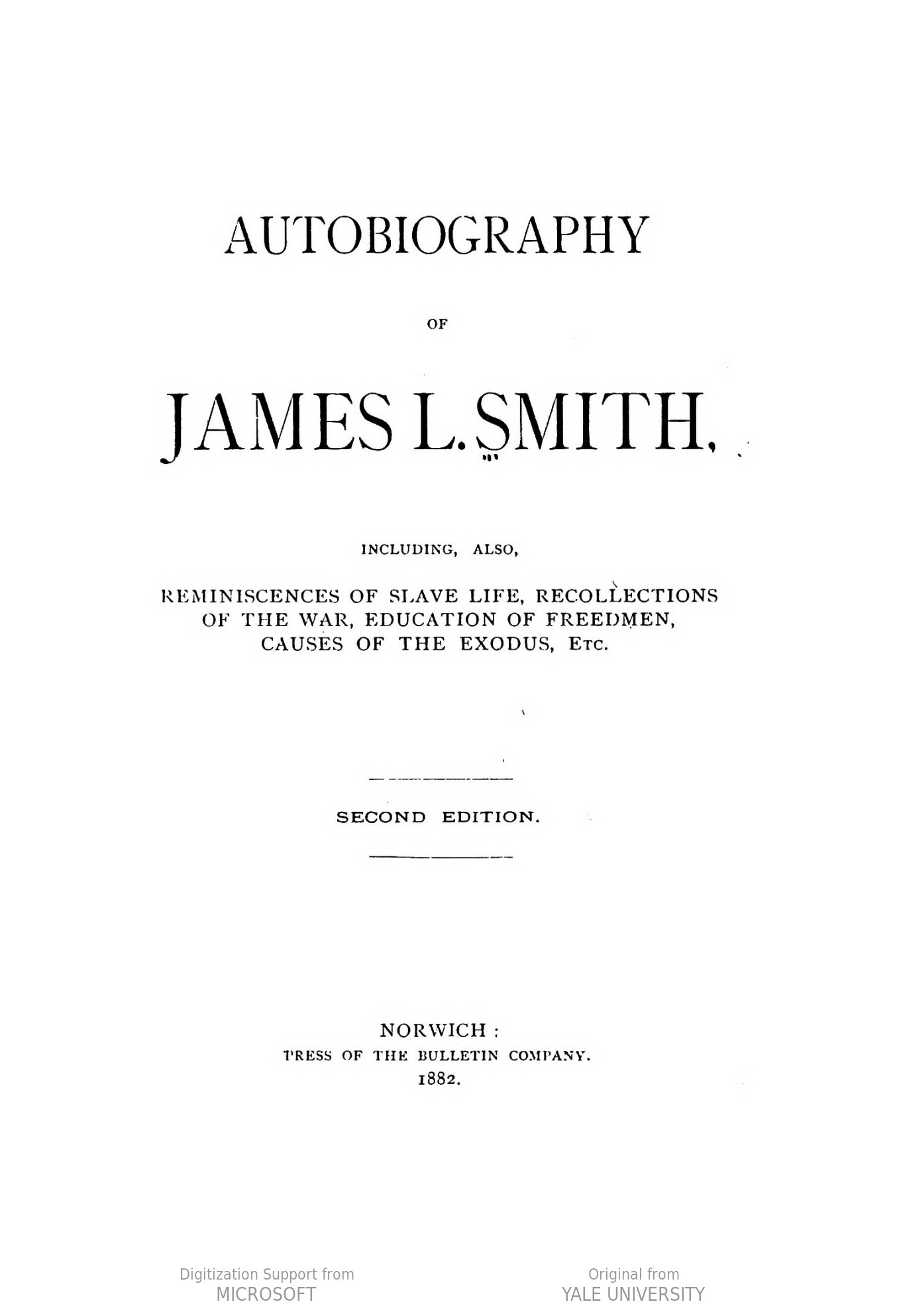Regan Miner
The Norwich Historical Society
TEACHER'S SNAPSHOT
Course Topics/Big Ideas:
Role of Connecticut in U.S. History, The Struggle for Freedom, Equality, and Social Justice
Town:
Norwich
Grade:
Grade 8
Lesson Plan Notes
James Lindsey Smith (c. 1816 – c. 1884) fought for liberty and human dignity in an era of social and political upheaval. As an escaped slave from Virginia, Smith became a successful shoemaker and church leader in Norwich, Connecticut. His journey to freedom embodies the struggle of those who escaped from slavery to make new lives in the North in the years before the Civil War.
The history of James Lindsey Smith is multi-faceted and touches upon slavery, racial issues, education, political history, and religion. This presents a valuable opportunity to educate students about a powerful and inspirational example of how an escaped slave traveled north for his freedom and how settling in Norwich, Connecticut changed his life.
ESSENTIAL QUESTION
SUPPORTING QUESTIONS
- How can James Lindsey Smith’s autobiography help us understand what life was like for African Americans in the South and in the North in the years before and after the United States Civil War?
- How does James Lindsey Smith’s story fit into the larger discussions of African American history in the United States?
- Would James Lindsey Smith view America today as a land of opportunity?
- How do you think James Lindsey Smith would respond to the Civil Rights movement of the mid-20th century and the current Black Lives Matter movement?
ACTIVITY
1. As an introduction, discuss the differences between primary and secondary sources and the value of each for historians:
- What are examples of primary sources? (diaries, photographs, newspaper articles from the time, etc.)
- What are examples of secondary sources? (books written later by researchers, documentary videos, museum exhibits, etc.)
- Which category does autobiography belong to? (primary source, but from one person’s perspective and relying on their own memory)
- How are both primary and secondary sources useful in learning about the past?
2. Introduce the compelling question and share the video and map from the toolkit with students as background about the life of James Lindsey Smith. Have students develop a list of questions that they have in response to the video and map and explain that together they will see how many of these they can answer from reading parts of Smith’s narrative. Others might require additional research.
3. Break the class into five groups. Each group will read one excerpt from Smith’s narrative that focuses on a particular theme.
- Enslavement/Life in the South (pages 1-2 [ending at “death claimed him for his own.”]; pages 7-8 [“our dress” to “aching hearts”]; page 15)
- Escape from Slavery (page 41 [last paragraph] to page 43 [“anxious hearts”]; pages 46-49)
- Life in Norwich (pages 68-71 [to “after nine o’clock”])
- Fugitive Slave Act (pages 90-92)
- Civil War (pages 82-86 [to “to a band of colored soldiers.”] and page 118 [“as soon as it was made known…”] to page 121 [“where a splendid feast awaited them.”]
Ask students to consider questions like:
- What experiences is Smith sharing in this section of his narrative?
- What challenges did Smith face? What opportunities did he have?
- What is the tone of this section?
- What do you think Smith’s purpose was in including this section in his narrative?
4. Have each group share their portions of Smith’s narrative and their thoughts about it with the rest of the class, reporting in chronological order. Revisit the supporting and compelling questions to wrap up the inquiry and discuss where students can learn more or find answers to remaining questions.
OPPORTUNITIES FOR ASSESSMENT
- Writing Prompt: James Lindsey Smith’s story is one of perseverance and resilience. What are the most important lessons James Lindsey Smith wants to impart on his readers? Use passages from the autobiography to support your argument.
- Creative Project: Students will create their own walking tour based on sites in Norwich that are related to James Lindsey Smith and create a map of relevant sites to accompany their walking tour. Students will present their walking tours to peers, either in person (if possible) or virtually.
- Research Project: Students will research William Grimes, James Mars, or Venture Smith, three other Connecticut men who were formerly enslaved and went on to write narratives about their experiences (links provided below.) Students will create a graphic organizer or presentation comparing and contrasting this man’s story and narrative with that of James Smith.
RESOURCE TOOL KIT

“From Slavery to Freedom: the Story of James L. Smith” video (9 min), Norwich Historical Society, 2021.
This source can be used to give students a brief overview and introduction of James Lindsey Smith’s life and provide some context to the autobiography.

Map of Smith’s journey on the Underground Railroad. Created by Miranda Creative for Norwich Historical Society, 2023.
This map will help students visualize Smith’s journey from slavery to freedom.

Smith, James L. The Autobiography of James L. Smith. Norwich: Press of the Bulletin Company, 1881.
Digital version: Yale University, courtesy of HathiTrust Digital Library.
Text version: Documenting the American South.
This primary source can help students understand what life was like for African Americans in the 19th century.
ADDITIONAL RESOURCES
Places to GO
Sites on the Connecticut Freedom Trail
Things To DO
Read another autobiography of a formerly enslaved person in Connecticut:
- Grimes, William. Life of William Grimes, the Runaway Slave. New York, 1825.
Digital version: University of Virginia, courtesy of HathiTrust Digital Library
Text only version: Documenting the American South - Mars, James. Life of James Mars, a Slave Born and Sold in Connecticut. Written by Himself. Hartford, Conn.: Press of Case, Lockwood & Co., 1869.
Digital version: Emory University, courtesy of HathiTrust Digital Library
Text only version: Documenting the American South - Smith, Venture. A Narrative of the Life and Adventures of Venture, a Native of Africa: But Resident above Sixty Years in the United States of America, Related by Himself. New London, CT: C. Holt, 1798.
Digital version: Yale University, Beinecke Rare Book and Manuscript Library
Text only version: Documenting the American South
Or, take a look at some other sources related to the life of James Smith and Norwich at the time:
- Map of Norwich, 1833
- Map of Norwich showing sites related to James L. Smith
- Bird’s-eye view of Norwich, 1876
- Video: Shoemaking Demonstration from Old Sturbridge Village (4:38)
- Historic Image: African Methodist Episcopal choir, Norwich
- Historic Image: African Methodist Episcopal Church, Norwich
- Historic Image: 1860 view of Downtown Norwich
- Historic Image: Original Main Building at Norwich Free Academy
- Historic Image: Historic postcard images of Jail Hill
- Modern Image: View from Jail Hill
- Modern Image: James L. Smith’s house on School Street
- Modern Image: Norwich Free Academy
- Modern Image: David Ruggles Freedom Courtyard
- Book: White, Richard. Jordan Freeman Was My Friend. Xlibris Corporation, 2003.
Websites to VISIT
“Connecticut’s Black Governors.” Museum of Connecticut History
ConnecticutHistory.org Topic Page—Slavery and Abolition
Articles to READ
ConnecticutHistory.org:
- “James Lindsey Smith Takes The Underground Railroad to Connecticut” by Nancy Finlay
- “29th Regiment Connecticut Volunteers Fought More than One War” by Todd Jones
- “Connecticut’s Black Governors” by Andy Piascik
Libby, Sam. “Jail Hill’s Rich History is Reborn in Research.” New York Times, March 28, 1999.



